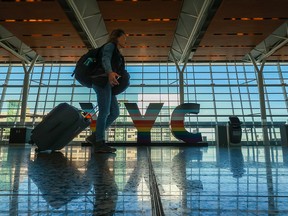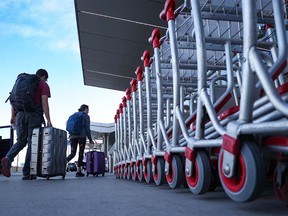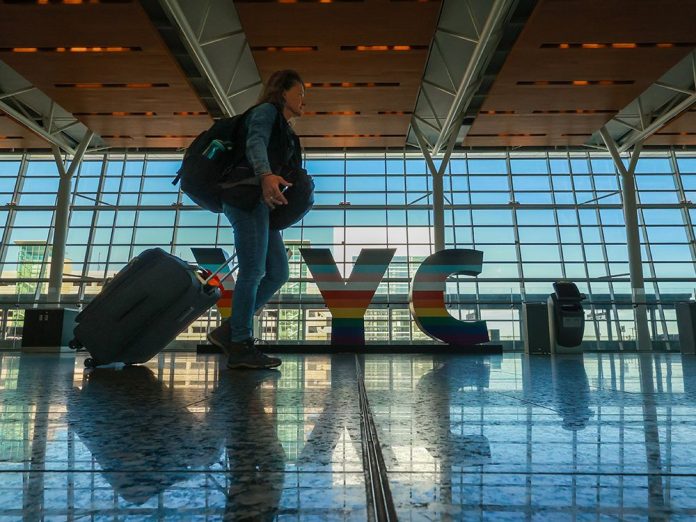Breadcrumb Trail Links
For airlines, masks will no longer be mandatory, and travellers will no longer have to submit public health information through ArriveCAN
 Passengers move through the Calgary International Airport on Monday. Gavin Young/Postmedia
Passengers move through the Calgary International Airport on Monday. Gavin Young/Postmedia
Article content
As the federal government announced on Monday that all COVID travel restrictions and requirements will be lifted on Oct. 1, the entire tourism sector in Alberta let out a collective sigh of relief.
Advertisement 2
This advertisement has not loaded yet, but your article continues below.
Article content
“That’s welcome news,” said Cindy Ady, CEO of Tourism Calgary. “It’s one that we’ve been advocating for because the restrictions and measures have been reported as a barrier for our international visitors … the thicker and the stickier your border is the more difficult that becomes.”
By clicking on the sign up button you consent to receive the above newsletter from Postmedia Network Inc. You may unsubscribe any time by clicking on the unsubscribe link at the bottom of our emails. Postmedia Network Inc. | 365 Bloor Street East, Toronto, Ontario, M4W 3L4 | 416-383-2300
Thanks for signing up!
Article content
Health Minister Jean-Yves Duclos announced the government would not be renewing COVID-19 border measures, set to expire on Sept. 30. Vaccinations will not be required to pass through customs at ports of entry for foreign nationals, no more random COVID-19 tests and unvaccinated Canadians will no longer be forced to isolate upon return to the country.
For airlines, masks will no longer be mandatory, travellers will no longer have to submit public health information through the ArriveCAN app or website, and people no longer have to monitor and report symptoms.
Advertisement 3
This advertisement has not loaded yet, but your article continues below.
Article content
Ady points to the international traveller as being critical to the sector due to how much more they spend than leisure travellers. Tourism Calgary numbers have international air travel still down 32 per cent from 2019 numbers.
The travel sector has been pushing for months for many of these restrictions to be dropped, saying they have placed undue harm on an industry that has been unjustly singled out by the federal government.
On Friday, the Canadian Travel and Tourism Roundtable released a report that examined the pandemic border and travel policies authored by four Canadian doctors specializing in infectious diseases, emergency medicine and pandemic management. The study concluded four major points:
• Border measures have been largely ineffective at stopping variants of concern;
Advertisement 4
This advertisement has not loaded yet, but your article continues below.
Article content
• There is no convincing evidence that pre-departure and on-arrival testing and surveillance had a significant impact on transmission;
• Travel-related testing is ineffective in identifying COVID-19 cases and preventing the spread of the virus;
• The masking obligation is inconsistent from a public policy perspective.
Perrin Beatty, president of the Canadian Chamber of Commerce and a member of the roundtable, said travel by air was one of the safest modes of transportation due to the high air exchange rates.
“The costs associated with that in terms of mental health, in terms of social impacts, and in terms of the economy, vastly outweigh any benefits that have come from the restrictions we put in place,” he said. “(Aircraft) is far safer than any office building, any sports arena, any supermarket that you’re in, and yet we treat air travel as if it were the single most dangerous thing that Canadians could be doing. It’s perverse and it’s something that is costing our economy billions of dollars.”
Advertisement 5
This advertisement has not loaded yet, but your article continues below.
Article content
 Passengers move through the Calgary International Airport on Monday. Gavin Young/Postmedia
Passengers move through the Calgary International Airport on Monday. Gavin Young/Postmedia
Chris Miles, vice-president of operations and infrastructure at Calgary International Airport, said the airport went from about 50,000 passengers a day in 2019 to 200 outbound passengers a day at the lowest points of the pandemic. He noted the airport had bounced back to about 90 per cent of pre-pandemic traffic for August.
YYC was spared some of the headline-grabbing issues that other major international airports in Canada, like Toronto and Vancouver, experienced, but they still faced major challenges on a daily basis related to the regulations.
“What we will see out of this is simplicity being brought back to the travel experience; overseas guests as they come into Canada are going to have a much simpler process,” said Miles. “It will align us with some of the other jurisdictions that had sort of relaxed these measures well in advance of what Canada has done … And that’s great for travel and it encourages travel into the country, because some of these restrictions did have that impact on demand, and people not wanting to come in because of the complexity and the testing regime that existed.”
Advertisement 6
This advertisement has not loaded yet, but your article continues below.
Article content
-

Feds lift border vaccine mandates, mandatory masks on planes and trains
-

Bucket-list adventures are trending for fall and winter travel
-

Calgary airport boosts hiring as travel approaches pre-pandemic levels
The airport authority did take advantage of the pandemic to institute new technology to improve the customer experience and ability for people to move through the airport, and those advancements will continue.
WestJet applauded the announcement by Duclos and noted the struggles of the airline over the last couple of years, going from 15,000 employees, down to 5,000 and thousands of cancelled flights and confusion for travellers.
Pre-pandemic, the Calgary-based airline was at more than 700 flights per day and has now managed to get back to 500-525 flights this fall. Its capacity also remains below pre-pandemic levels and is working to rebuild its system. This winter, it plans to be back to 107 destinations, which will match 2019 levels.
Advertisement 7
This advertisement has not loaded yet, but your article continues below.
Article content
“The impact’s been extraordinary, this is the greatest crisis our company’s ever had financially, operationally and otherwise,” said Andrew Gibbons, vice-president of government relations and regulatory affairs for WestJet.
“The toll on our people has been immense. And there’s been times of great frustration around these measures. Many times we thought a lot of these measures were unjustified and not substantiated. So we’ve been quite vocal. Today’s a day I think we can say that we were heard, and it’s an opportunity for us and the government to move on.”
 Passengers walk past luggage carts on their way into the Calgary International Airport on Monday. Gavin Young/Postmedia
Passengers walk past luggage carts on their way into the Calgary International Airport on Monday. Gavin Young/Postmedia
The dropping of restrictions does not come in time for the big summer travel season. However, the hope is that it will revitalize business travel in Canada, for conferences or regular business. The sub-sector was one of the first to get wiped out and has long been viewed as the last to return due to the logistics and planning required.
Advertisement 8
This advertisement has not loaded yet, but your article continues below.
Article content
Tourism Calgary is banking on it as the BMO Centre expansion continues at Stampede Park.
“For those that are deciding where to take their convention or their piece of business, they’re looking at everything and one of those things is ‘Can we get our travellers into your country without a lot of extra layers of protocols?’” said Ady.
The lifting of restrictions came with a caveat from Duclos, that they can be brought back if needed for future waves or pandemics. Darren Reeder, president of the Tourism Industry Association of Alberta, said if that happens, he hopes the government does so with proper engagement from the industry. He also wants to see science drive the response.
“Any discussion about the ‘why’ must be informed by all the best available data shows best-case and worst-case scenarios, and prescribed timelines, timelines for how long we expect those measures to be in place,” said Reeder. “The most difficult part of the experience the last 2½ years was businesses having to blindly follow what government was intending to do with policy and not knowing when and how adjustments might be made.”
jaldrich@postmedia.com
Twitter: @JoshAldrich03
Share this article in your social network
Advertisement 1
This advertisement has not loaded yet, but your article continues below.
Comments
Postmedia is committed to maintaining a lively but civil forum for discussion and encourage all readers to share their views on our articles. Comments may take up to an hour for moderation before appearing on the site. We ask you to keep your comments relevant and respectful. We have enabled email notifications—you will now receive an email if you receive a reply to your comment, there is an update to a comment thread you follow or if a user you follow comments. Visit our Community Guidelines for more information and details on how to adjust your email settings.













